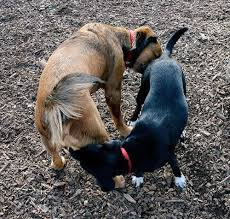So you're getting ready to bring home a new puppy or dog and you want to make sure you have everything your new pal will need. You have picked out the perfect collar and chosen the right kind of leash. You have a crate and a bed for the pup, and his own special bowls. The only other thing your pooch will need is toys. How do you know what to buy? What is best for puppies? Should you get hard chew toys or soft, squeaky toys? If you've been in the local pet store, you'll know there are tons of things to choose from. This may not seem like a very important decision, but in fact, having toys for your puppy or dog is crucial to his health and development.
Toys and chews provide a puppy or dog the ability to enjoy something that is natural for them. Make sure your pup knows which things are his to chew on, or he will go look for something on his own. Toys and bones provide an outlet for a dog to release pent up energy or relieve boredom. Chewing is good for their teeth and jaws, as well as being a good stress reliever.
 |
| Teething Toy |
The types of toys you will need to buy will depend on several things. Puppies are teething and as their permanent teeth come in, they will lose the puppy teeth. Toys for a small or medium breed puppy or a small breed dog need to be small enough for the dog to carry around and small enough for them to get their mouth on it. A large breed puppy can be bigger than a small breed full grown. There are toys and chew designed specifically for puppies or small breeds and toys for large breed, powerful chewers.
Another thing to consider is what type of toys will your dog need. Should you buy bones, or balls or rawhide or squeaky toys? Once you decide what is the best size for your puppy or dog, consider
how he or she will play with the toys. You should provide a variety of toys. A ball or a tug toy is great for playing with your dog. An appropriate size bone is good for your dog to keep himself occupied. Most dog experts recommend some type of puzzle toy where the pup has to figure out and work the toy to get a treat stashed inside. Many puppies, and even older dogs like to have a soft, stuffed animal toy. It becomes a comforting toy and they will not chew it or tear it up. My 3 Dobermans and probably other large breeds, like to tear apart anything like that, so we have no stuffed toys in my house!
how he or she will play with the toys. You should provide a variety of toys. A ball or a tug toy is great for playing with your dog. An appropriate size bone is good for your dog to keep himself occupied. Most dog experts recommend some type of puzzle toy where the pup has to figure out and work the toy to get a treat stashed inside. Many puppies, and even older dogs like to have a soft, stuffed animal toy. It becomes a comforting toy and they will not chew it or tear it up. My 3 Dobermans and probably other large breeds, like to tear apart anything like that, so we have no stuffed toys in my house!
Always keep an eye on your pup and his toys. Be aware if they are broken or torn in pieces and throw them out as needed, to prevent him or her from swallowing something that could obstruct the esophogus or intestines. Rawhides and certain other chews can cause problems for some puppies and dogs so always ask your veterinarian for his advice and recommendation.
Source:https://ezinearticles.com/?Why-Your-Dog-Needs-Toys&id=3097937






















































